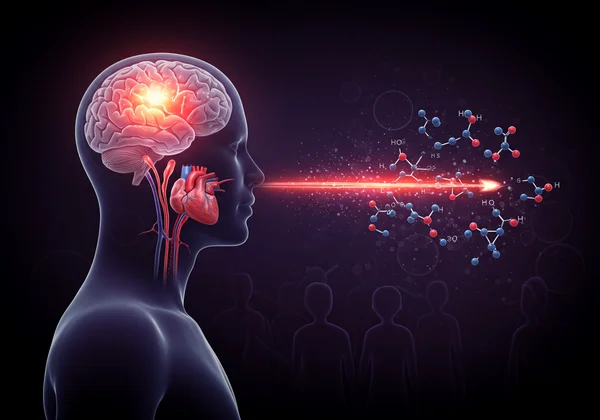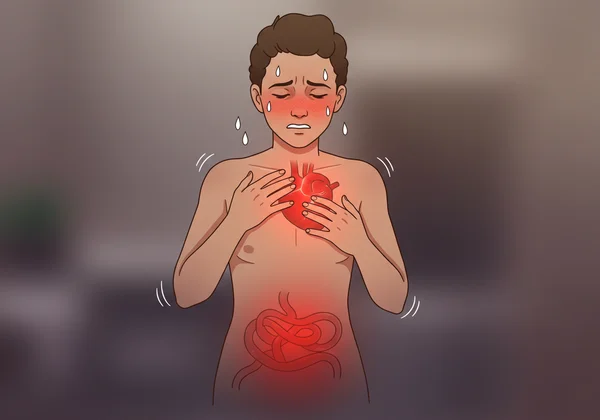Understanding Social Anxiety Symptoms: How the LSAS Test Can Help
You're about to give a presentation, and suddenly your heart is pounding, your palms are sweaty, and your stomach is in knots. You might dismiss it as just a case of "the nerves," but have you ever wondered if there's more to it? The physical symptoms of social anxiety are more than just a fleeting feeling; they are powerful, tangible reactions. Is it just nerves, or is your body trying to tell you something more? Understanding these signals is the first step toward gaining clarity and control. For many, quantifying this experience can be a powerful next step, something you can do with a free online test.
Why Your Body Reacts: The Science of Social Anxiety
Those intense physical sensations aren't just "in your head." They are the result of a complex and ancient biological system designed for survival. When your brain perceives a threat—whether it's a tiger in the jungle or a room full of colleagues—it triggers a powerful alarm. In social anxiety, this alarm system becomes overly sensitive to social situations, interpreting them as genuine dangers.
Understanding the "Fight-or-Flight" Response
At the heart of anxiety's physical symptoms is the fight-or-flight response, an automatic physiological reaction. Managed by your autonomic nervous system, this response prepares your body to either confront a threat or flee to safety. It’s a brilliant survival mechanism, but when it's triggered by non-threatening social events like making small talk or eating in front of others, it can feel overwhelming and confusing.
How Social Situations Become Perceived Threats
For individuals with social anxiety, the fear of judgment, embarrassment, or scrutiny is so intense that the brain flags these social scenarios as legitimate threats. Your brain doesn't differentiate between a physical danger and a perceived social one; it just reacts. This perceived threat detection system kicks your body into high gear, readying it for a battle that exists only in the mind.
The Role of Adrenaline and Cortisol in Anxiety
When the fight-or-flight alarm sounds, your adrenal glands release a flood of stress hormones, primarily adrenaline and cortisol. Adrenaline is responsible for the immediate, powerful symptoms: the racing heart, rapid breathing, and surge of energy. Cortisol, the body's primary stress hormone, sustains this state of high alert. While helpful in short bursts, chronically elevated cortisol levels from persistent anxiety can lead to long-term health effects.

7 Common Physical Signs of Social Anxiety
While blushing is the classic image of social discomfort, the physical experience is far more diverse and intense. Recognizing these signs in yourself is a crucial step in understanding your own patterns of social anxiety.

Racing Heart and Chest Tightness
One of the most common signs is an anxiety racing heart or palpitations. Your heart beats faster to pump more oxygenated blood to your muscles, preparing them for action. This can be accompanied by a feeling of tightness or pressure in the chest, which is often frightening and mistaken for a heart attack, adding another layer of fear to the experience.
Excessive Sweating or Hot Flashes
Do you experience social anxiety sweating? This is your body's cooling system kicking into overdrive. As your metabolic rate increases during the fight-or-flight response, your body generates more heat. Sweating is its way of preventing overheating, but in a social context, it can become a source of intense self-consciousness and embarrassment.
Stomach Pain, Nausea, or Digestive Distress
The gut-brain connection is powerful. During an anxiety response, your body diverts blood away from non-essential systems like digestion to focus on your muscles. This can lead to a range of uncomfortable symptoms, including stomach pain social anxiety, nausea, cramps, and an urgent need to use the restroom. It's why your stomach often feels like it's "in knots."
Trembling, Shaking, or Twitching
The surge of adrenaline can cause your muscles to become tense and primed for action, resulting in visible trembling or shaking. This often affects the hands and legs and can make your voice quiver. Like sweating, this visible symptom can amplify your fear of being judged, creating a vicious cycle of anxiety. If you feel this way, it may be helpful to take a self-assessment.
Shortness of Breath or Dizziness
When you're anxious, your breathing pattern often changes, becoming shallow and rapid (hyperventilation). While the goal is to get more oxygen, this can ironically lead to feeling short of breath or dizzy. The lightheadedness occurs because rapid breathing disrupts the balance of carbon dioxide and oxygen in your blood.
Blushing and Feeling Flushed
Blushing is caused by the dilation of blood vessels in your face, a response triggered by the rush of adrenaline. It's an involuntary reaction that signals embarrassment or self-consciousness to others, making it one of the most dreaded symptoms for those with social anxiety. The sensation of heat spreading across your face and neck can be intensely uncomfortable.
Muscle Tension and Headaches
Anxiety makes you physically tense up, as your muscles brace for the perceived threat. This chronic muscle tension, especially in the neck, shoulders, and back, can lead to persistent aches and pains. Over time, this constant clenching can also contribute to tension headaches or even migraines, turning social stress into lingering physical pain.
When to Pay Attention: Is It More Than Shyness?
It's normal to feel nervous or shy sometimes. The key distinction between shyness and social anxiety lies in the intensity of the fear and the degree of avoidance it causes. How do you know when these physical symptoms point to something more significant?
Evaluating the Impact on Your Daily Life
Ask yourself: Do these physical symptoms and the fear behind them stop you from doing things you want or need to do? Do you turn down promotions, avoid social gatherings, or struggle in class because of them? When social fear consistently disrupts your personal, academic, or professional life, it’s a sign that it may be more than shyness. To get a clear picture of your situation, an objective measure can be invaluable.
The Key Difference: Fear and Avoidance
Social anxiety is characterized by a powerful combination of fear and avoidance. You don't just dislike social events; you actively dread them and go to great lengths to avoid them. When you can't avoid a situation, you endure it with intense distress. This pattern of avoidance is what shrinks your world and maintains the cycle of anxiety.

Important: Ruling Out Other Medical Conditions
It is crucial to note that many of these physical symptoms can also be caused by other medical issues, such as thyroid problems or heart conditions. Before concluding that your symptoms are solely due to anxiety, it's always wise to consult with a doctor to rule out any underlying physical health conditions. This article is for informational purposes and is not a substitute for professional medical advice.
Your Next Step: Turn Understanding into Action
You now know that your pounding heart and knotted stomach are not just 'nerves'—they are real, biological signals. This understanding is the first step toward taking control. It validates your experience and moves it from a place of confusion to one of understanding. You now have the knowledge to see these signals not as a personal failure, but as your body's overactive alarm system.
Understanding is the first step. The next is to gain a clearer, more objective picture of your personal social comfort levels.
Take our free LSAS test to get your confidential Liebowitz Social Anxiety Scale score in just a few minutes. This can provide a valuable baseline, helping you move from understanding your symptoms to gaining actionable insight into your life.
Frequently Asked Questions About Social Anxiety
Do I have social anxiety or am I just shy?
Shyness is a personality trait involving feeling reserved or nervous in new situations, but it doesn't typically stop you from living your life. Social anxiety involves an intense fear of being judged and scrutinized, leading to significant emotional distress and avoidance of social situations that impacts your daily functioning and relationships.
What is considered severe social anxiety?
Severity is generally determined by how much the anxiety interferes with your life. Severe social anxiety often involves intense physical symptoms and persistent fear across a wide range of social situations, leading to significant avoidance that can affect your career, education, and ability to form relationships. An assessment tool can provide a score that helps contextualize this severity.
How can I get an LSAS score to understand my level?
Getting an LSAS score is simple and confidential. The Liebowitz Social Anxiety Scale is a trusted, scientifically validated questionnaire designed to measure fear and avoidance in social situations. You can get your LSAS score right now by taking our free online assessment to gain a better understanding of where you stand.